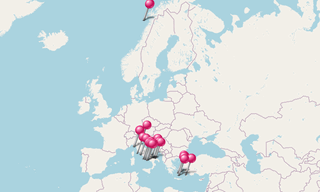Santorini (Σαντορίνη), classically Thera, and officially Thira, is the largest island of a small, circular archipelago which bears the same name and is the remnant of a volcanic caldera. Santorini is essentially what remains after an enormous volcanic explosion that destroyed the earliest settlements on a formerly single island, and created the current geological caldera.
A giant central, rectangular lagoon, which measures about 12 by 7 km², is surrounded by 300 m, steep cliffs on three sides. On the fourth side, the lagoon is separated from the sea by another much smaller island called Therasia; the lagoon is connected to the sea in two places, in the north-west and south-west.
The depth of the caldera is 400 m. The major settlements include Fira, Oia, Emporio, Kamari, Perissa, Imerovigli, Pyrgos, and Therasia.
The capital, Fira, clings to the top of the cliff looking down on the lagoon. The volcanic rocks present from the prior eruptions feature olivine and have a small presence of hornblende. It is the most active volcanic centre in the South Aegean Volcanic Arc, though what remains today is chiefly a water-filled caldera.
The island is the site of one of the largest volcanic eruptions in recorded history: the Minoan Eruption, which occurred some 3600 years ago at the height of the Minoan Civilization. The eruption left a large caldera surrounded by volcanic ash deposits hundreds of metres deep and may have led indirectly to the collapse of the Minoan Civilization on the island of Crete, 110 km to the south, through a gigantic tsunami.
Another popular theory holds that the Thera eruption is the source of the legend of Atlantis.
Excavations starting in 1967 at the site called Akrotiri under the late Professor Spyridon Marinatos have made Thera the best-known Minoan site outside of Crete, the homeland of the culture. Only the southern tip of a large town has been uncovered, yet it has revealed complexes of multi-level buildings, streets, and squares with remains of walls standing as high as eight metres, all entombed in the solidified ash of the famous eruption of Thera.
The site was not a palace-complex such as are found in Crete, but its excellent masonry and fine wall-paintings show that this was certainly no conglomeration of merchants’ warehousing either. A loom-workshop suggests organised textile weaving for export. This Bronze Age civilization thrived between 3000 and 2000 BC, and reached its peak in the period 2000 to 1580 BC.
The well preserved ruins of the ancient town often are compared to the spectacular ruins at Pompei in Italy.
Santorini remained unoccupied throughout the rest of the Bronze Age, during which time the Greeks took over Crete. Probably after what is called the Bronze Age collapse, Phoenicians founded a site on Thera. Herodotus reports that they called the island Callista and lived on it for eight generations. In the 9th century BC, Dorians founded the main Hellenic city on Mesa Vouno, 396 m above sea level. This group later claimed that they had named the city and the island after their leader, Theras. Today, that city is referred to as Ancient Thira.

-Oia.hero.landscape.jpg)

-Oia.jpg?w=256)
-Oia.jpg?w=256)
-Oia.jpg?w=256)
-Oia.jpg?w=256)
-Ancient-Thira.jpg?w=256)
-Fira.jpg?w=256)
-Oia.jpg?w=256)
-Oia.jpg?w=256)
-Fira.jpg?w=256)
-Oia.jpg?w=256)
-Oia.jpg?w=256)
-Oia.jpg?w=256)
-Ancient-Thira.jpg?w=256)
-Ancient-Thira.jpg?w=256)
-Oia.jpg?w=256)
-Oia.jpg?w=256)
-Ancient-Thira.jpg?w=256)
-Oia.jpg?w=256)
-Oia.jpg?w=256)
-Oia.jpg?w=256)
-Fira.jpg?w=256)
-Oia.jpg?w=256)
-Fira.jpg?w=256)
-Oia.jpg?w=256)
-Oia.jpg?w=256)
-Fira.jpg?w=256)
-Oia.jpg?w=256)
-Firostafani.jpg?w=256)
-Fira.jpg?w=256)
-Fira.jpg?w=256)
-Ancient-Thira.jpg?w=256)
-Oia.jpg?w=256)
-Oia.jpg?w=256)
-Fira.jpg?w=256)
-Oia.jpg?w=256)
-Firostafani.jpg?w=256)
-Oia.jpg?w=256)
-Fira.jpg?w=256)
-Ancient-Thira.jpg?w=256)
-Akrotiri.jpg?w=256)
-Oia.jpg?w=256)
-Oia.jpg?w=256)
-Fira.jpg?w=256)
-Fira.jpg?w=256)
-Oia.jpg?w=256)
-Akrotiri.jpg?w=256)
-Oia.jpg?w=256)
-Ancient-Thira.jpg?w=256)
-Fira.hero.jpg?w=320)

.hero.jpg?w=320)

.hero.jpg?w=320)

-Naoussa.hero.jpg?w=320)

-Fira.jpg?w=256)
-Ancient-Thira.jpg?w=256)
-Akrotiri.jpg?w=256)
-Oia.jpg?w=256)
-Fira.jpg?w=256)
-Oia.jpg?w=256)
-Ancient-Thira.jpg?w=256)
-Oia.jpg?w=256)
-Oia.jpg?w=256)
-Ancient-Thira.jpg?w=256)
-Oia.jpg?w=256)
-Fira.jpg?w=256)
-Oia.jpg?w=256)
-Ancient-Thira.jpg?w=256)
-Ancient-Thira.jpg?w=256)
-Oia.jpg?w=256)
-Oia.jpg?w=256)
-Oia.jpg?w=256)
-Oia.jpg?w=256)
-Oia.jpg?w=256)
-Ancient-Thira.jpg?w=256)
-Oia.jpg?w=256)
-Oia.jpg?w=256)
-Ancient-Thira.jpg?w=256)
-Oia.jpg?w=256)
-Fira.jpg?w=256)
-Oia.jpg?w=256)
-Oia.jpg?w=256)
-Oia.jpg?w=256)
-Oia.jpg?w=256)
-Akrotiri.jpg?w=256)
-Oia.jpg?w=256)
-Oia.jpg?w=256)
-Fira.jpg?w=256)
-Ancient-Thira.jpg?w=256)
-Oia.jpg?w=256)
-Akrotiri.jpg?w=256)
-Fira.jpg?w=256)
-Oia.jpg?w=256)
-Oia.jpg?w=256)
-Oia.jpg?w=256)
-Oia.jpg?w=256)
-Ancient-Thira.jpg?w=256)
-Oia.jpg?w=256)
-Oia.jpg?w=256)
-Oia.jpg?w=256)
-Oia.jpg?w=256)
-Oia.jpg?w=256)
-Oia.jpg?w=256)
-Oia.jpg?w=256)
-Oia.jpg?w=256)
-Ancient-Thira.jpg?w=256)
-Oia.jpg?w=256)
-Oia.jpg?w=256)
-Oia.jpg?w=256)
-Fira.jpg?w=256)
-Oia.jpg?w=256)
-Oia.jpg?w=256)
-Fira.jpg?w=256)
-Oia.jpg?w=256)
-Oia.jpg?w=256)
-Ancient-Thira.jpg?w=256)
-Oia.jpg?w=256)
-Akrotiri.jpg?w=256)
-Oia.jpg?w=256)
-Oia.jpg?w=256)
-Oia.jpg?w=256)
-Ancient-Thira.jpg?w=256)
-Oia.jpg?w=256)
-Oia.jpg?w=256)
-Ancient-Thira.jpg?w=256)
-Fira.jpg?w=256)
-Oia.jpg?w=256)
-Oia.jpg?w=256)
-Oia.jpg?w=256)
-Ancient-Thira.jpg?w=256)
-Oia.jpg?w=256)
-Oia.jpg?w=256)
-Akrotiri.jpg?w=256)
-Oia.jpg?w=256)
-Oia.jpg?w=256)
-Fira.jpg?w=256)
-Oia.jpg?w=256)
-Oia.jpg?w=256)
-Oia.jpg?w=256)
-Akrotiri.jpg?w=256)
-Oia.jpg?w=256)
-Oia.jpg?w=256)
-Oia.jpg?w=256)
-Fira.jpg?w=256)
-Ancient-Thira.jpg?w=256)
-Oia.jpg?w=256)
-Oia.jpg?w=256)
-Oia.jpg?w=256)
-Oia.jpg?w=256)
-Oia.jpg?w=256)
-Oia.jpg?w=256)
-Oia.jpg?w=256)
-Oia.jpg?w=256)
-Oia.jpg?w=256)
-Firostafani.jpg?w=256)
-Ancient-Thira.jpg?w=256)
-Oia.jpg?w=256)
-Firostafani.jpg?w=256)
-Ancient-Thira.jpg?w=256)
-Fira.jpg?w=256)
-Oia.jpg?w=256)
-Oia.jpg?w=256)
-Oia.jpg?w=256)
-Oia.jpg?w=256)
-Oia.jpg?w=256)
-Oia.jpg?w=256)
-Oia.jpg?w=256)
-Oia.jpg?w=256)
-Ancient-Thira.jpg?w=256)
-Oia.jpg?w=256)
-Ancient-Thira.jpg?w=256)
-Oia.jpg?w=256)
-Oia.jpg?w=256)
-Oia.jpg?w=256)
-Fira.jpg?w=256)
-Oia.jpg?w=256)
-Oia.jpg?w=256)
-Oia.jpg?w=256)
-Oia.jpg?w=256)
-Ancient-Thira.jpg?w=256)
-Oia.jpg?w=256)
-Oia.jpg?w=256)
-Fira.jpg?w=256)
-Oia.jpg?w=256)
-Oia.jpg?w=256)
-Oia.jpg?w=256)
-Oia.jpg?w=256)
-Fira.jpg?w=256)
-Firostafani.jpg?w=256)
-Oia.jpg?w=256)
-Oia.jpg?w=256)
-Akrotiri.jpg?w=256)
-Ancient-Thira.jpg?w=256)
-Oia.jpg?w=256)
-Oia.jpg?w=256)
-Oia.jpg?w=256)
-Akrotiri.jpg?w=256)
-Oia.jpg?w=256)
-Oia.jpg?w=256)
-Oia.jpg?w=256)
-Oia.jpg?w=256)
-Oia.jpg?w=256)
-Oia.jpg?w=256)
-Oia.jpg?w=256)
-Oia.jpg?w=256)
-Ancient-Thira.jpg?w=256)